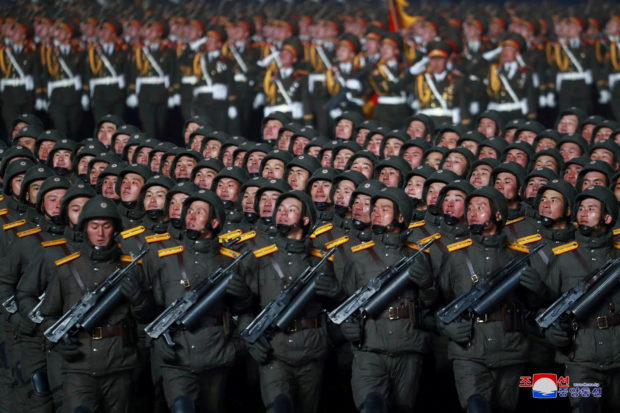
Troops march during a military parade to commemorate the 8th Congress of the Workers’ Party in Pyongyang, North Korea January 14, 2021 in this photo supplied by North Korea’s Central News Agency (KCNA). REUTERS FILE PHOTO
SEOUL — North Korea staged a parade of “paramilitary and public security forces” in Pyongyang in the early hours of Thursday, state media reported, the nuclear-armed nation’s third procession in less than a year.
Pyongyang has continued to pursue its nuclear weapons and ballistic missile programs — for which it is internationally sanctioned — during the diplomatic engagement of recent years and often uses military parades to show off its latest developments.
At the last one in January — days before Joe Biden’s inauguration as US president — submarine-launched ballistic missiles rolled through Kim Il Sung Square in front of a grinning Kim Jong Un, with the official KCNA news agency describing them as the “world’s most powerful weapon”.
But Thursday’s event was significantly less assertive, including detachments from the railways ministry, Air Koryo and the Hungnam Fertilizer Complex, and no mention of strategic weapons systems on display.
Leader Kim appeared before the cheering crowd as fireworks went off at midnight and “extended warm greetings to all the people of the country”, KCNA reported. It did not quote him giving a speech.
The pageant featured Red Guards and members of the ruling Workers’ Party, it said, as well as parachutists, mechanized paramilitary units and a flypast.
Co-operative farm workers drove “tractors hauling artillery pieces to pound the aggressors and their vassal forces with annihilating firepower in case of emergency”, KCNA added.
But instead of the giant missiles — whether real or models — that are the usual climax to a military parade, the last unit to enter the square was the public security forces’ fire brigade.
“We are closely monitoring the situation,” an official of South Korea’s defense ministry told AFP. “More details require further analysis.”
‘Dead of night’
Pyongyang has previously used parades to send messages to audiences abroad and at home, usually timing them to coincide with anniversaries.
Thursday marks 73 years since the foundation of the Democratic People’s Republic of Korea, as the North is officially known.
But three displays in the space of 12 months — a military parade in January marked a five-yearly congress of the ruling Workers’ Party, and came after one in October for the organization’s 75th anniversary — is unusually frequent.
It has not carried out a nuclear test or an intercontinental ballistic missile launch since 2017.
Instead, Pyongyang has looked to exploit parades without risking escalation, said Hong Min, a senior researcher at the Korea Institute for National Unification in Seoul.
“The only other way to show off their strategic weapons is to launch them, which carries the risk of sparking protest and further international sanctions,” he told AFP.
“The North must have felt a need to apply pressure to the US to come to the negotiating table” on its terms, he added.
Nuclear talks with the United States have been at a standstill since the collapse of a 2019 summit in Hanoi between Kim and then president Donald Trump over sanctions relief and what North Korea would be willing to give up in return.
Biden’s North Korea envoy Sung Kim has repeatedly expressed his willingness to meet his North Korean counterparts “anywhere, at any time”.
The Biden administration has promised a “practical, calibrated approach”, including diplomatic efforts, to persuade Pyongyang to give up its banned weapons programs.
But the impoverished North has never shown any indication it would be willing to surrender its nuclear arsenal, and has rebuffed South Korean efforts to revive dialogue.
Last month, the UN atomic agency (IAEA) said Pyongyang appeared to have started its plutonium-producing reprocessing reactor at Yongbyon, calling it a “deeply troubling” development, and Kim’s sister and key adviser Kim Yo Jong demanded the withdrawal of US troops from the peninsula.
At the same time, North Korea is under a self-imposed coronavirus blockade, having closed its borders to protect against the coronavirus that first emerged in neighboring China, adding to the pressure on its moribund economy.
Domestically the parade was an opportunity to shore up morale and “mass solidarity for the regime”, Hong Min added.
“Taking place in the dead of night, it gives the public something to enjoy.”